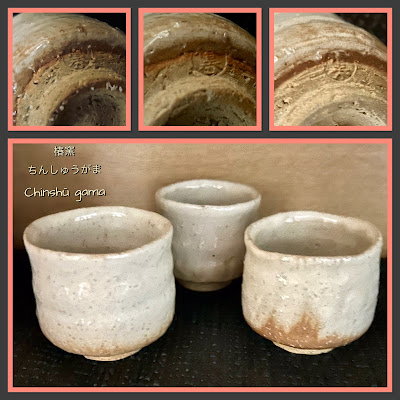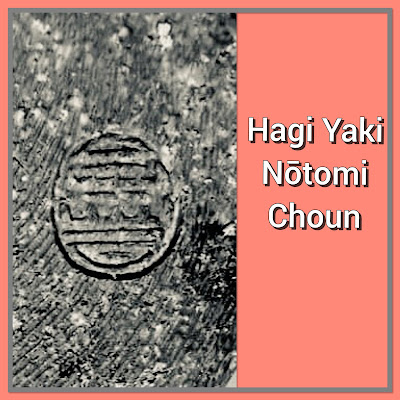Sunday, September 25, 2011
Friday, September 16, 2011
HAGI YAKI (萩焼き )-Ceramics of Yamaguchi Prefecture
There is an old Japanese saying when referring to the best pottery for the tea ceremony: "Ichi-raku, Ni-Hagi, San-Karatsu". First is raku, second Hagi and third Karatsu.
I learned from a friend that rough Hagi clay is called Oni- Hagi (鬼萩) and smooth is called Hime-Hagi (姫萩). Some of each are shown here.
Why the notched foot?
https://www.hagiyaki-kaikan.com/stories/高台の切り込みは何のため?/
*******************
Generic Hagi Marks
上手 急須 土瓶 Uwate kyusu dobin
萩燒 (燒 is an alternate form for yaki 焼, meaning to bake or for pottery to fire)

****************************************************************
CHIN SHU GAMA (椿秀窯)
AKA Shutōen kiln ( Master potter Sho Keiichirō)
Link: http://www.hagiyaki.co.jp/kaisha.html
This mottled look is called Gohonde which is a popular style in HAGI ware.
HAGIDONO GAMA (萩殿窯)
TENPOZAN ZO 天鵬山造
*Hara Shoun MARK
UNMARKED
HAGI RYUZAN (萩竜山)
TENPOZAN ZO 天鵬山造
 |
| Tenpozan Kiln |
 | ||||
Vase-Tenpozan
The master potter is Hirose Tanga. ********************************************************************** JYOZAN-GAMA |
|
|
| Box marked Shouraian, Jyozan Zo Cups marked Jyozan |
|
|
| Jozan-gama meoto "couple" teacup By Jyozan 城山 Jyozan kiln has many potters and support employees. The head of the kiln is Kaneko Nobuhiro |
********************************************************************
Marked Kasen 華扇
***********************************************************
SHOU-UN
*Hagi Yaki tea bowl by Shoun (祥雲)
*Hara Shoun MARK
Mr. Hara was born in Izumo, made Hagi and Izumo wares, later went to Kyoto, studied Korean pottery. He built a kiln in Uji, Kyoto named Seiwa Gama. Later wares carry the Seiwa Mark (清和).
Here is a box from the same tea bowl. It states Hagi Yaki made by Shoun.
UNMARKED
Friday, September 9, 2011
What an undertaking!
When I started my quest to discover the artists, kilns and retailers who made and sold the pieces I have collected little did I know just how many kilns, and artists there were! Since I have embarked on this project I have learned a lot of vocabulary, kanji characters and possible readings. I find it interesting that Japanese people are not necessarily any farther ahead than I am with reading the marks on the pieces. Some artists writing reminds me of all the jokes made about the illegibility of doctor's handwriting. The other factors of multiple readings of a character, as well as the carved "hanko" designs for making the marks on the pottery and the boxes make for a difficult task. I will continue to share what I am learning and hopefully it will be of some use to my readers. Keep in mind that I am not Japanese and I am involved in a complex learning process!
Subscribe to:
Comments (Atom)
Featured Post
Helpful Vocabulary When Researching Japanese Ceramics
Vocabulary when searching for Japanese Ceramics *I will be adding to this list Dating ( 江戸) Edo Period (1603-1868) (江戸 前期) Ea...
-
From 1921-1941, wares from Japan exported to the United States had to be marked "Japan" or "Made in Japan". During Wor...
-
Kutani ware is from Ishikawa Prefecture. The markings are often in red, but can be impressed, in blue, gold and sometimes black with a g...
-
The This company was in business from 1954-1994. It was bought out by Enesco in 1994. Registered in NYC and San Francisco. Recognized by it...









































